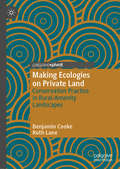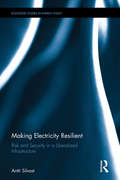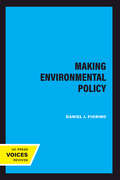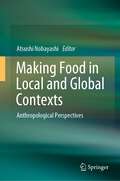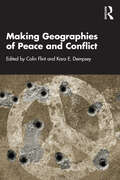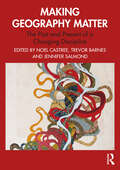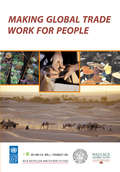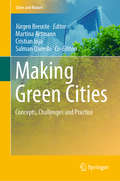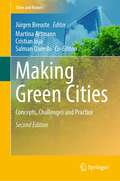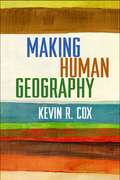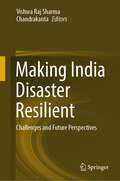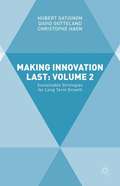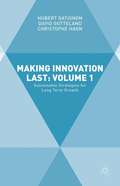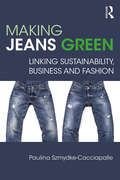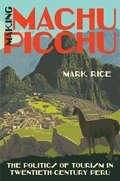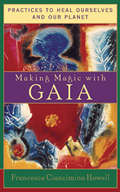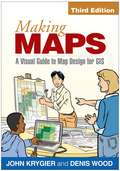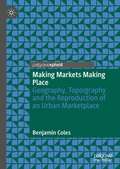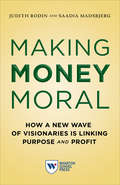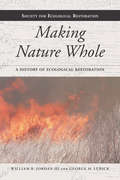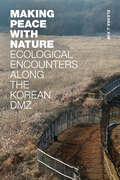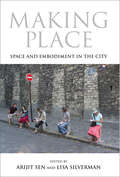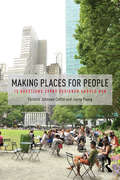- Table View
- List View
Making Ecologies on Private Land: Conservation Practice in Rural-Amenity Landscapes
by Ruth Lane Benjamin CookeThis book explores conservation practices on private land, based on research conducted with landholders in the hinterlands of Melbourne, Australia. It examines how conservation is pursued as an intimate interaction between people and ecologies, suggesting that local ecologies are lively participants in this process, rather than simply the object of conservation, and that landholders develop their ideas of environmental stewardship through this interaction. The book also explores the consequences of private property as a form of spatial organisation for conservation practice; the role of formative interactions with ecologies in producing durable experiential knowledge; how the possibilities for contemporary conservation practice are shaped by historical landscape modification; and how landholders engage with conservation covenants and payment schemes as part of their conservation practice. The authors conclude with ideas on how goals and approaches to private land conservation might be reframed amid calls for just social and ecological outcomes in an era of rapid environmental change.
Making Electricity Resilient: Risk and Security in a Liberalized Infrastructure (Routledge Studies in Energy Policy)
by Antti SilvastEnergy risk and security have become topical matters in Western and international policy discussions; ranging from international climate change mitigation to investment in energy infrastructures to support economic growth and more sustainable energy provisions. As such, ensuring the resilience of more sustainable energy infrastructures against disruptions has become a growing concern for high-level policy makers. Drawing on interviews, participant observation, policy analysis, and survey research, this book unpacks the work of the authorities, electricity companies, and lay persons that keeps energy systems from failing and helps them to recover from disruptions if they occur. The book explores a number of important issues: the historical security policy of energy infrastructures; control rooms where electricity is traded and maintained in real time; and electricity consumers in their homes. Presenting case studies from Finland and Scandinavia, with comparisons to the United States, the United Kingdom, and the European Union at large, Making Electricity Resilient offers a detailed and innovative analysis of long-term priorities and short-term dynamics in energy risk and resilience. This book will be of great interest to students and scholars of energy policy and security, and science and technology studies.
Making Environmental Policy
by Daniel J. FiorinoWho speaks for the trees, the water, the soil, and the air in American government today? Which agencies confront environmental problems, and how do they set priorities? How are the opposing claims of interest groups evaluated? Why do certain issues capture the public's attention?In Making Environmental Policy, Daniel Fiorino combines the hands-on experience of an insider with the analytic rigor of a scholar to provide the fullest, most readable introduction to federal environmental policymaking yet published. A committed environmental advocate, he takes readers from theory to practice, demonstrating how laws and institutions address environmental needs and balance them against other political pressures.Drawing on the academic literature and his own familiarity with current trends and controversies, Fiorino offers a lucid view of the institutional and analytic aspects of environmental policymaking. A chapter on analytic methods describes policymakers' attempts to apply objective standards to complex environmental decisions. The book also examines how the law, the courts, political tensions, and international environmental agencies have shaped environmental issues. Fiorino grounds his discussion with references to numerous specific cases, including radon, global warming, lead, and hazardous wastes. Timely and necessary, this is an invaluable handbook for students, activists, and anyone wanting to unravel contemporary American environmental politics.
Making Food in Local and Global Contexts: Anthropological Perspectives
by Atsushi NobayashiThis book is a collection of research focusing on the anthropological aspects of how food is made in modern society from both global and local perspectives. Modern food consumed in any society is created in a variety of natural and cultural environments. There is a "food democracy" in which how we procure and share food can be an indicator of our participation in society, while food nurtured in particular climates and land can be transmitted to the outside world owing to the influence of tourism and the global economy, a phenomenon that is recognized on a global scale as exemplified by the UNESCO Intangible Cultural Heritage. In other words, food is an aspect of both culture and civilization. Anthropological approaches are used to reveal the humanistic aspects of food, highlighting the strength and individuality of regional and ethnic foods in global civilizations. The book is a compilation of results from sessions of the international symposium “Making Food in Human and Natural History”, which took place on March 18 and 19, 2019, in Osaka, Japan.
Making Geographies of Peace and Conflict
by Colin Flint Kara E. DempseyThis book illustrates the diversity of current geographies, ontologies, engagements, and epistemologies of peace and conflict. It emphasizes how agencies of peace and conflict occur in geographic settings, and how those settings shape processes of peace and conflict. The essence of the book’s logic is that war and peace are manifestations of the intertwined construction of geographies and politics. Indeed, peace is never completely distinct from war. Each chapter in the book will demonstrate understandings of how the myriad spaces of war and peace are forged by multiple agencies, some possibly contradictory. The goals of these agents vary as peace and war are relational, place-specific processes. The reader will understand the mutual construction of spaces and processes of peace and conflict through engagement with the concepts of agency, the mutual construction of politics and space, geographic scales, multiple geographies, the twin dynamics of empathy/othering and inclusivity/partitioning, and resistance/militarism. The book discusses the intertwined nature of peace and conflict, including reference to the environment, global climate change, borders, technology, and postcolonialism. This book is valuable for instructors teaching a variety of senior level human geography courses, including graduate-level classes. It will appeal to those working in political geography, historical geography, sociology of geographic knowledge, feminist geography, cultural and economic geography, political science, and international relations.
Making Geography Matter: The Past and Present of a Changing Discipline
by Noel Castree Trevor Barnes Jennifer SalmondWhat is the purpose of Geography? What do geographers study and why? How do they seek to shape the world they interrogate?This book addresses these questions by examining the lives and works of individual geographers, both past and present. Like all disciplines, Geography is no more nor less than the collective endeavours of researchers and teachers operating in specific contexts. The contexts both shape, and are shaped by, these individuals. This book’s biographical and autobiographical chapters transport readers to the times and places where geographers have sought to make Geography matter. The result is a more vivid, grounded understanding of the discipline than the many high-level surveys of geographic thought paradigms currently written for university students.This book’s accessible essays each conclude with a study task. Making Geography Matter is aimed at university students and their teachers who wish to understand the goals, history and evolving practice of Geography. It provides an alternative perspective – both concrete and engaging – to the many student-focussed texts that map out numerous ‘isms and ologies’.
Making Global Trade Work for People
by Kamal MalhotraThe world's trade regime is promoted by international agencies and most governments as the best way to lift the poor out of poverty and achieve sustainable development. But does it contribute to human development or not? This reassessment looks in detail at the way it has worked under the GATT and under the World Trade Organization, and analyses how it is working and how it can be improved. The book aims to make major contribution to the debates surrounding globalization and the impact of trade on the poor, on social stability and on the environment. It is intended to provide a benchmark for future policy discussion and analysis.
Making Green Cities: Concepts, Challenges and Practice (Cities and Nature)
by Jürgen Breuste Martina Artmann Cristian Ioja Salman QureshiThis book shows what role nature can play in a city and how this can make it a better place for people to live. People, planners, designers and politicians are working towards the development of green cities. Some cities are already promoted as green cities, while others are on their way to become one. But their goals are often unclear and can include different facets. Presenting contributions from world leading researchers in the field of urban ecology, the editors provide an interdisciplinary overview of best practices and challenges in creating green cities. They show examples of how to build up these cities from bits and pieces to districts and urban extensions. Each example concludes with a summary of the collected knowledge, the learning points and how this can be used in other places. The best practices are collected from around the world – Europe, Australia, America and Asia. The new dynamic urban development of Asia is illustrated by case studies from China and the Indian subcontinent. The reader will learn which role nature can play in green cities and what the basic requirements are in terms of culture, pre-existing nature conditions, existing urban surroundings, history, design and planning.
Making Green Cities: Concepts, Challenges and Practice (Cities and Nature)
by Jürgen Breuste Martina Artmann Cristian Ioja Salman QureshiThis book shows what role nature can play in a city and how this can make it a better place for people to live. People, planners, designers and politicians are working towards the development of green cities. Some cities are already promoted as green cities, while others are on their way to become one. But their goals are often unclear and can include different facets. Presenting contributions from world leading researchers in the field of urban ecology, the editors provide an interdisciplinary overview of best practices and challenges in creating green cities. They show examples of how to build up these cities from bits and pieces to districts and urban extensions. Each example concludes with a summary of the collected knowledge, the learning points and how this can be used in other places. The best practices are collected from around the world – Europe, America and Asia. Contributions cover a wide range of biophysical and cultural backgrounds within these three continents, including the Central, Southern and Eastern European region, as well as Latin and North America. The new dynamic urban development of Asia is illustrated by case studies from China and the Indian subcontinent. The reader will learn which role nature can play in green cities and what the basic requirements are in terms of culture, pre-existing nature conditions, existing urban surroundings, history, design and planning.
Making Hay
by Verlyn KlinkenborgMaking Hay gives us an unforgettable glimpse of everyday life on the family farms of northwestern Iowa, southwestern Minnesota, and Montana's Big Hole Valley. Klinkenborg evokes a way of life at risk, and weaves an unforgettable story of the richness of rural living.
Making Healthy Places: Designing and Building for Well-Being, Equity, and Sustainability
by Andrew L. Dannenberg Howard Frumkin Nisha BotchweyThe first edition of Making Healthy Places offered a visionary and thoroughly researched treatment of the connections between constructed environments and human health. Since its publication over 10 years ago, the field of healthy community design has evolved significantly to address major societal problems, including health disparities, obesity, and climate change. Most recently, the COVID-19 pandemic has upended how we live, work, learn, play, and travel. <p><p>In Making Healthy Places, Second Edition: Designing and Building for Well-Being, Equity, and Sustainability, planning and public health experts Nisha D. Botchwey, Andrew L. Dannenberg, and Howard Frumkin bring together scholars and practitioners from across the globe in fields ranging from public health, planning, and urban design, to sustainability, social work, and public policy. This updated and expanded edition explains how to design and build places that are beneficial to the physical, mental, and emotional health of humans, while also considering the health of the planet. <p><p>This edition expands the treatment of some topics that received less attention a decade ago, such as the relationship of the built environment to equity and health disparities, climate change, resilience, new technology developments, and the evolving impacts of the COVID-19 pandemic. <p><p>Drawing on the latest research, Making Healthy Places, Second Edition imparts a wealth of practical information on the role of the built environment in advancing major societal goals, such as health and well-being, equity, sustainability, and resilience. <p><p>This update of a classic is a must-read for students and practicing professionals in public health, planning, architecture, civil engineering, transportation, and related fields.
Making Human Geography
by Kevin R. CoxThis book cogently examines how human geography has developed from a field with limited self-awareness regarding method and theory to the vibrant study of society and space that it is today. Kevin R. Cox provides an interpretive, critical perspective on Anglo-American geographic thought in the 20th and 21st centuries. He probes the impact of the spatial-quantitative revolution and geography's engagement with other social sciences, particularly in social theory. Key concepts and theories in the field are explained and illustrated with instructive research examples. Cox explores both how new approaches to human geography get constructed and what each school of thought has contributed to understanding the world in which we live.
Making India Disaster Resilient: Challenges and Future Perspectives
by Chandrakanta Vishwa Raj SharmaVarious natural and man-made hazards are nowadays increasingly considered as disasters, particularly by individual and communities are lacking in awareness and where a system as a whole has no adequate management mechanism. Consequently, the world is facing serious negative outcome in form of loss of life, injury, disability, loss of property, infrastructure, and economic disruption followed by psycho-social disorders. Other than this, disasters adversely affect wildlife and environment in long terms. Developing countries are worst sufferers as these regions are poorly prepared for potential hazards at one hand and are exposed to disasters due to the complexity of (socio-cultural, economic and physical) vulnerability. Government, World communities, NGOs are recognizing the problems and are trying to build resilient communities to reduce disaster impact at various levels.Year 1990-99 was observed as the decade for natural disaster reduction by United Nations (UN) and United Nations International Strategy for Disaster Reduction (UNISDR) was established to support and coordinate this movement. Year 2015 has been very important in the history as three global agreements have been signed by global communities (Sustainable development goals, Paris agreement and Sendai framework for DRR). Where, SDGs are extension of MDGs to make the planet more sustainable. It proposed 17 goals and 15 years’ time frame adopted in the year 2015. SDGs target various social, cultural, economic, challenges followed by wildlife, environmental protection through knowledge share and technological innovation among all member countries. In December 2015, UNFCCC reached a landmark agreement to combat climate change and to accelerate and intensify the actions and investments needed for a sustainable low carbon future known as Paris agreement. Sendai Framework 2015 is voluntary, non-binding agreement which recognizes that the state has the primary role to reduce disasterrisk but that responsibility should be shared with other stakeholders including local government, the private sector and other stakeholders. This framework focuses on the pre-disaster management rather than post disaster relief and recovery. This book is an insight into the various issues related to the emerging disasters (both natural and man-made), vulnerable communities, and government initiatives taken with a geographical focus on India. This volume contains selected chapters written by faculty and research scholars. This book is an empirical work on disasters vulnerabilities and management which will benefit researchers, academicians, professional, practitioners and policy makers.
Making Innovation Last: Sustainable Strategies For Long Term Growth
by Hubert Gatignon David Gotteland Christophe HaonMaking Innovation Last considers the long term success of a firm. Authored by a trio of top international scholars who present pioneering new work on what it takes to create long term growth, the book examines the internal conditions that are likely to encourage sustainable innovation, as well as what a culture of innovation should look like.
Making Innovation Last: Sustainable Strategies for Long Term Growth
by Hubert Gatignon David Gotteland Christophe HaonMaking Innovation Last considers the long term success of a firm. Authored by a trio of top international scholars who present pioneering new work on what it takes to create long term growth, the book examines the internal conditions that are likely to encourage sustainable innovation, as well as what a culture of innovation should look like.
Making Jeans Green: Linking Sustainability, Business and Fashion
by Paulina Szmydke-CacciapalleConsumers spend approximately $93 billion on denim products every year. This consumption comes at a great cost, with thousands of litres of fresh water, hazardous chemicals and energy contributing to just one pair of jeans, leaving the environment and the industry vulnerable to pollution and climate change. Using facts, figures, case studies and anecdotes, this book investigates why the industry has been so slow to adopt green technologies and offers practical solutions to designers and fashion executives who want to switch to cleaner manufacturing, including those working in the ‘fast fashion’ sector. It also offers advice to the eco-conscious consumer who wants to purchase denim more sustainably. Considering the full lifecycle of a pair of jeans from the cotton crop to disposal, it presents examples of how to go green at different stages. This book will be of great interest to fashion students and researchers, as well as designers, fashion executives, policy-makers and anyone who comes into contact with the world of denim.
Making Machu Picchu: The Politics of Tourism in Twentieth-Century Peru
by Mark RiceSpeaking at a 1913 National Geographic Society gala, Hiram Bingham III, the American explorer celebrated for finding the "lost city" of the Andes two years earlier, suggested that Machu Picchu "is an awful name, but it is well worth remembering." Millions of travelers have since followed Bingham's advice. When Bingham first encountered Machu Picchu, the site was an obscure ruin. Now designated a UNESCO World Heritage Site, Machu Picchu is the focus of Peru's tourism economy. Mark Rice's history of Machu Picchu in the twentieth century—from its "discovery" to today's travel boom—reveals how Machu Picchu was transformed into both a global travel destination and a powerful symbol of the Peruvian nation.Rice shows how the growth of tourism at Machu Picchu swayed Peruvian leaders to celebrate Andean culture as compatible with their vision of a modernizing nation. Encompassing debates about nationalism, Indigenous peoples' experiences, and cultural policy—as well as development and globalization—the book explores the contradictions and ironies of Machu Picchu's transformation. On a broader level, it calls attention to the importance of tourism in the creation of national identity in Peru and Latin America as a whole.
Making Magic with Gaia: Practices to Heal Ourselves and Our Planet
by Francesca Ciancimino HowellThe author of Food, Festival and Religion shows how spiritual practices drawn from the ancient magical arts can help to heal Mother Earth. A Greenpeace activist, Wiccan High Priestess, and proud Soccer Mom, Francesca Howell has been involved in magical traditions and wildlife preservation since childhood. In this one-of-a-kind book, she shares her everyday suggestions for spiritual renewal through connecting with nature. The meditations, ceremonies, and spellcraft in Making Magic with Gaia spring from an ancient Pagan tradition of Earth stewardship, which blends deep ecology, magic, and activism to bring the reader into a closer communion and harmony with Mother Earth. Packed with practical suggestions (recycling, gardening without pesticides, and conserving water) and mystical rituals (shamanism, crystal magic, and Power Animals) for helping the planet, this book is written for anyone with a spiritual ecological awareness. Not the witchcraft of Gothic novels, Making Magic with Gaia is based on a modern religion with ancient roots that can heal the Earth as it heals the practitioner.
Making Maps: A Visual Guide to Map Design for GIS
by Denis Wood John KrygierAll components of map making are covered: titles, labels, legends, visual hierarchy, font selection, how to turn phenomena into visual data, data organization, symbolization, and more. Innovative pedagogical features include a short graphic novella, good design/poor design map examples, end-of-chapter suggestions for further reading, and an annotated map examplar that runs throughout the book.
Making Markets Making Place: Geography, Topo/graphy and the Reproduction of an Urban Marketplace
by Benjamin ColesThis book examines place and place-making in London’s Borough Market. In particular, it uses topo/graphy (‘place-writing) to interrogate the ways in which Borough Market’s material, social-sensual and discursive relations assemble to reproduce Borough Market as a place, market and marketplace. Its central premise is that market-processes – the negotiation and exchange of commodities –are place-processes. This means that the often-abstract relationships that ultimately define what we think of as the economy are embedded in the rich and every materiality, sociality, sensuality and meanings associated with place. By tracing out these different elements, topo/graphy illustrates the ways in which economic reproduction is grounded in particular and often discrete practices. However, by assembling them together, this highlights the ways in which place and place-making are the driving force behind the economy at large.
Making Money Moral: How a New Wave of Visionaries Is Linking Purpose and Profit
by Judith Rodin Saadia Madsbjerg“As we look ahead to the recovery from the COVID-19 crisis, Making Money Moral could not come at a better time.”—Jamie Dimon, Chairman and Chief Executive Officer, JPMorgan ChaseThe math doesn’t add up: Global financial markets can no longer ignore the world’s most critical problems. The risks are too high and the costs too great.In Making Money Moral: How a New Wave of Visionaries Is Linking Purpose and Profit, authors Judith Rodin and Saadia Madsbjerg explore a burgeoning movement of bold and ambitious innovators. These trailblazers are unlocking private-sector investments in new ways to solve global problems, from environmental challenges to social issues such as poverty and inequality. They are earning great returns and reimagining capitalism in the process. Pioneers in the field of sustainable and impact investing, Rodin and Madsbjerg offer first-hand stories of how investors of every type and in every asset class are investing in world-changing solutions—with great success. Meet the visionaries who are leading this movement:The investment managers putting trillions of dollars to work, like TPG, Wellington Management, State Street Global Advisors, Nuveen, Amundi, APG and Natixis;The asset owners driving the transition, like GPIF and PensionDanmark;A new generation of entrepreneurs benefiting from the investments, like DreamBox Learning, an innovative educational technology platform, and Goodlife Pharmacies, which is disrupting the traditional notion of a pharmacy; The corporations that are repurposing their business models to meet demand for sustainable products and services, like Ørsted; andThe nonprofits that are reimagining how to raise money for their work while creating significant value for investors, like The Nature Conservancy.In their book, Rodin and Madsbjerg offer a deep look at the most powerful tools available today—and how they can be unlocked. They reveal:Who the investors are and what they want;How innovative products and investment strategies can deliver long-term value for investors while improving lives and protecting ecosystems;How leaders can build strategies and prepare their organizations to enter and expand this dynamic market; andHow to measure impact, understand critical regulations, and avoid potential pitfalls.A roadmap to making the financial market a force for good, Making Money Moral is a must-read for those seeking private-sector capital to address a big problem, as well as those seeking both to mitigate risk and to invest in big solutions.“Judith Rodin and Saadia Madsbjerg identify an important new way of looking at money: from the root of all evil to the fount of all solutions. Their timely, important book on impact investing is full of powerful insights and compelling examples they’ve seen firsthand. Their work will be sure to accelerate momentum toward a more sustainable world.”—Rosabeth Moss Kanter, Harvard Business School Professor and Author of Think Outside the Building: How Advanced Leaders Can Change the World One Smart Innovation at a Time
Making Nature Whole: A History of Ecological Restoration (Science Practice Ecological Restoration)
by William R. Jordan III George M. LubickMaking Nature Whole is a seminal volume that presents an in-depth history of the field of ecological restoration as it has developed in the United States over the last three decades. The authors draw from both published and unpublished sources, including archival materials and oral histories from early practitioners, to explore the development of the field and its importance to environmental management as well as to the larger environmental movement and our understanding of the world. Making Nature Whole is a landmark contribution, providing context and history regarding a distinctive form of land management and giving readers a fascinating overview of the development of the field. It is essential reading for anyone interested in understanding where ecological restoration came from or where it might be going.
Making Peace with Nature: Ecological Encounters along the Korean DMZ
by Eleana J. KimThe Korean Demilitarized Zone (DMZ) has been off-limits to human habitation for nearly seventy years, and in that time, biodiverse forms of life have flourished in and around the DMZ as beneficiaries of an unresolved war. In Making Peace with Nature Eleana J. Kim shows how a closer examination of the DMZ in South Korea reveals that the area’s biodiversity is inseparable from scientific practices and geopolitical, capitalist, and ecological dynamics. Drawing on ethnographic fieldwork with ecologists, scientists, and local residents, Kim focuses on irrigation ponds, migratory bird flyways, and land mines in the South Korean DMZ area, demonstrating how human and nonhuman ecologies interact and transform in spaces defined by war and militarization. In so doing, Kim reframes peace away from a human-oriented political or economic peace and toward a more-than-human, biological peace. Such a peace recognizes the reality of war while pointing to potential forms of human and nonhuman relations.
Making Place: Space And Embodiment In The City
by Arijit Sen Lisa SilvermanSpace and place have become central to analysis of culture and history in the humanities and social sciences. Making Place examines how people engage the material and social worlds of the urban environment via the rhythms of everyday life and how bodily responses are implicated in the making and experiencing of place. The contributors introduce the concept of spatial ethnography, a new methodological approach that incorporates both material and abstract perspectives in the study of people and place, and encourages consideration of the various levels--from the personal to the planetary--at which spatial change occurs. The book's case studies come from Costa Rica, Colombia, India, Austria, Italy, the United Kingdom, and the United States.
Making Places for People: 12 Questions Every Designer Should Ask
by Jenny Young Christie Johnson Coffin** Honorable Mention at the 2019 ERDA Great Places Awards ** Making Places for People explores twelve social questions in environmental design. Authors Christie Johnson Coffin and Jenny Young bring perspectives from practice and teaching to challenge assumptions about how places meet human needs. The book reveals deeper complexities in addressing basic questions, such as: What is the story of this place? What logic orders it? How big is it? How sustainable is it? Providing an overview of a growing body of knowledge about people and places, Making Places for People stimulates curiosity and further discussion. The authors argue that critical understanding of the relationships between people and their built environments can inspire designs that better contribute to health, human performance, and social equity—bringing meaning and delight to people’s lives.
